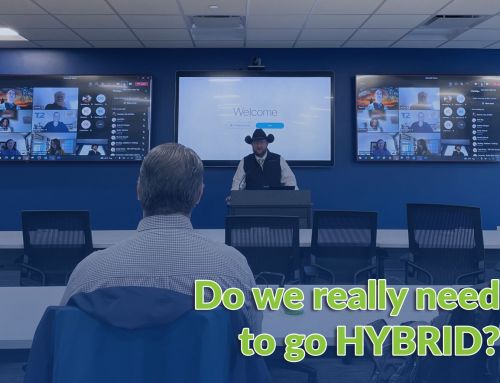I recently found myself at a hotel bar having a very frank conversation with a colleague that is an association event planner. She has recently been tasked to take over an event that had previously been planned by a third-party planner through a different association. She was on a site-review trip for the event and had just received the final budget details while on the trip.
Her experience to this point has primarily been large association meetings with around 750-1500 attendees – she has planned some incredible events. Looking at the budget for the new event, it quickly became apparent that the entire event budget was equivalent to what she had spent on just AV at her last annual meeting. Looking at hosting 250-300 attendees for multiple days while offering both evening large group and small group events was suddenly overwhelming, if not impossible, on the budget she had been given.
I shared some ideas and when we parted, I wished her luck. As I walked away, I chuckled a little to myself. She was aghast at the miniscule budget she had been given, but it was typical of what we are often tasked with at Meetings Northwest. Clients want to create a memorable and worthwhile event, but often don’t have realistic expectations of how far their budget monies will go. As planners, we have to find a middle-ground between expectations and reality.
As planners, we have to find a middle-ground between expectations and reality.
Is there a “normal” budget? In 2014, average event budgets exceeded $20,000 (as surveyed by Planning Pod) for the first time. What does this tell us? Not much, other than budgets are on the rise. As anyone in the industry knows, no two events are alike and budgets reflect that. Take home lesson: While the improved economy has helped expand budgets, clients (and planners) cannot assume that there is a one-size fits all event budget.
As planners, what are some best practices that we can use to ensure the success of all events, regardless of budget restrictions?
- Communication. Careful communication with the client at the start of any project is key. We find it useful to email them a questionnaire ahead of time that covers the basics of the event. Items such as desired date(s), location and projected attendance are covered in the email. A follow-up interview is then held in person or over the phone. This is a chance to discuss how the program will be developed, what social activities are desired, if vendors or sponsors will be included, and what level of registration costs the attendees will accept.
- Budget Preparation. With expectations fully outlined and anticipated revenue streams identified it becomes imperative to create as accurate and conservative budget as possible. For example, if the program calls for tours or other offsite events, transportation quotes will need to be gathered. Food and beverage menus should be drafted so an accurate estimate of costs can be determined. Additionally, will the program require special guest speakers that will need honorariums or travel costs reimbursed? EVERY aspect of the event must be examined and corresponding cost items added to the draft budget.
- Setting Expectations. Before beginning negotiations with caterers, AV providers, etc., take a moment and go back to the client with your budget numbers. Having their buy-in is a crucial step to ensure success of the event. Don’t be surprised if they are concerned with some of the projections. Use this as an opportunity to suggest cost saving measures – a cash bar instead of a hosted bar. Many of our university clients choose to provide a portion of the event’s AV needs (laptops, projectors, etc.). This saves them the rental fees normally associated with this equipment. Occasionally, a client will choose to increase the amount of funds available to the event after seeing what the original budget could get them. Regardless of the outcome of this discussion, you should walk away with a set of realistic expectations for the event that you both agree upon.
- Negotiation. It never hurts to ask! We strive to have a good (if not great) working relationship with all of our vendors. Specifically, we try to be sensitive to their needs (they have to make money too) while also ensuring that our clients get the best deal possible. When dealing with a tight budget, we’ll try to work with shoulder season dates or schedule an event during a “slow” day that normally wouldn’t be a big money-maker for the vendor. They appreciate the non-peak business and in turn will frequently give us a better deal. We examine/negotiate ALL event costs from transportation to giveaways. If vendors know we are flexible (willing to take two smaller busses instead of one large one), they are more apt to offer compromises on cost.
- Follow-through. It is easy, especially toward the end of the planning process, to let costs begin to slide a little. After all, you know you’ve already negotiated some great deals, shouldn’t that be enough to keep your budget on track for the duration of the event? Probably not. Last-minute and unexpected costs can quickly destroy a well-thought out budget. Besides planning for contingencies up front (be sure to budget for a tent if you are having an outside event), don’t let yourself be rushed into approving an unexpected cost just because the event is starting in two days. Take a few minutes, make a few phone calls or bring in some colleagues for a quick brainstorming session. Is there an alternate option? Is there a way to reduce the cost (different vendors, reduced scope, etc.)? If the expense cannot be avoided, can you remove another item from your budget to minimize the impact? Follow-through with the same care at the end of the event as you did at the beginning.
Everyone wants to see their event come to a successful conclusion and this is possible even on a shoe-string budget. Managing expectations, thinking creatively, and above all, using ALL available resources can keep all event stakeholders happy.
About the author:
Traci Ulberg, CMP actively chose to base her business (and life) in the beautiful state of Montana. It is here that she has found not only a talented pool of professionals, but also the post-work activities that help maintain a healthy life balance. She enjoys all things outdoors with her husband and three children. She also harbors a secret love for building and is known for lending a hand to friends and family that have framing, roofing, and wiring projects. No fear of heights here!








